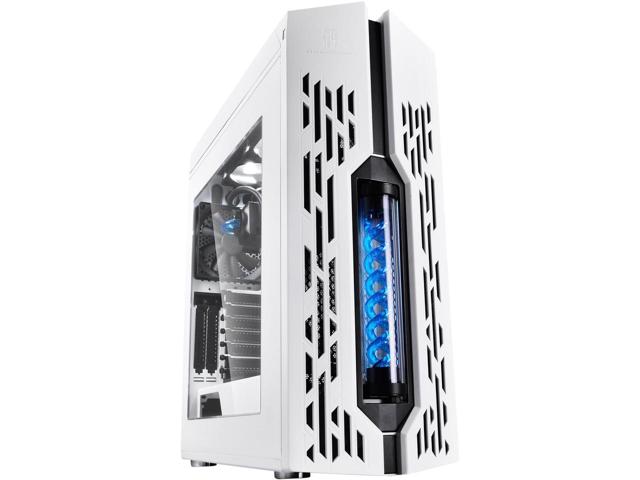
July 2016 marked the end of a less pleasant time in my life, and as a celebration of its closure, I treated myself to a completely new PC build, using the freshly released Nvidia 1080, and a lot of other high-end parts. To house this new build I wanted something aesthetically pleasing and notable that also supported a water cooling setup. After reading quite a few independent reviews, as well as sales site reviews, I settled on a white/blue Deepcool Genome. 
Upon assembling this beast of a machine, I was quite satisfied with the case and setup, aside from the lack of brightness on the helix (I already expected this thanks to some great reviews).
Later, I decided to flip my graphics card vertically for the visual effect of things. After doing so, I found the case’s first flaw: There was insufficient airflow for a large graphics card in the vertical position (as they suck air from where the window is, and that left little gap for intake). This was easily remedied by carving a hole, and adding a personal touch to my machine. 
With this, I ended up with something unique and functional, and things were good for a while. Unfortunately I later had difficulties with the quality of the cable I used for the vertical mount, and reverted back to a traditional horizontal mounting (this is relevant to the next part of my saga).
Fast forward to this last Friday. I work from home at my computer desk, though on a separate computer. While I was working, I noticed my desktop was making a gurgling sound (as though a water pump has insufficient water). It was relatively minor, but somewhat concerning, as the Genome should be a closed loop (no refilling ever needed). By the end of the day, the gurgling had gotten quite notable, and so I emailed Genome’s support about it, and continued on my merry way. I fired up a video game, and shortly into it my screens went black. My heart stopped, and I glanced over inside my case to find this: (That’s water on my 1080)
Little did I know, there is now a very commonly reported issue with the water cooling block failing on this case, but the reports of failures after 6-12 months only started coming into NewEgg AFTER I purchased mine, so I had no idea.
After recovering from the shock, and attempting to dry out my graphics card, I determined I’d need to put in a new watercooler. However, the original unit had the helix at the front of the case built into the loop. There was no way for me to incorporate it safely into a new system, and without it I would be left with an 8×2 gaping hole in the front of my case. This sparked an idea: Why did I need to keep what was there, or have a blank spot? Why not put something even cooler in its place? A trip to MicroCenter for a replacement cooler and some parts later, and I had my new plan: Embed a Raspberry Pi inside my case with a screen mounted in the gap where the helix was, and display anything I feel like on the Pi’s screen. With everything installed I was also able to check that my graphics card was luckily not damaged (whew). (Turns out it actually was damaged…it just didn’t fail under light strain)
It took a few attempts to get everything situated, but I now have a lan cable running from one of my two ports through my case and directly into the Pi, power being fed off the system’s USB 3.1 ports powering both the Pi and its screen, and a VNC/SSH accessible OS that allows me to control it however I want. The end result is rather amusing:
I’m rather pleased with the end result. Some simple linux-fu (involving gifview and xdotool) allows me to get the animations up on the screen on bootup. In the future I’d like to put in some live data (I.E. maybe temperature sensors, or “what I’m currently playing” type data) on the screen, but with a full-on Raspberry Pi in there, the sky’s the limit on what I can do when the time comes.
In summary: Sometimes something bad can be turned into something awesome.
Update:
After the system seemed to be ok for a day, it blacked out again after loading up a game. Turns out that basically the GPU, motherboard, and RAM ended up damaged from the shock. Deepcool was willing to help out, and I was able to rebuild the system, so things turned out ok.

